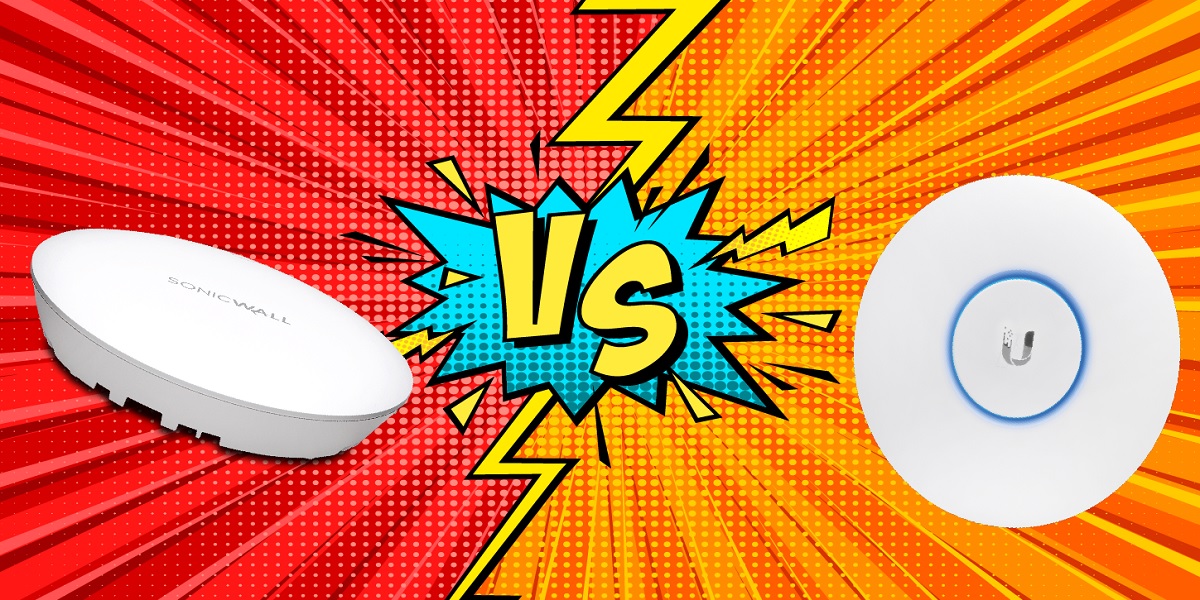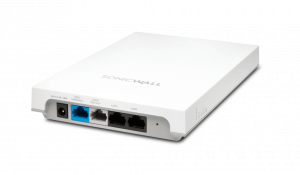SonicWave vs Ubiquiti Wireless Access Points
Comparing SonicWave wireless access points to competitors like Ubiquiti can pose a challenge. Which stats are important when selecting an AP? What makes SonicWave so secure? How does high performance Wave 2 wireless factor in when it comes to super fast WiFi at a low total cost?
SonicWave is the latest series of wireless access points from SonicWall. In short, Wave 2 wireless provides:
- Gigabit WiFi potential
- More bandwidth for connected devices
- Additional 5 GHz channels
- Improved user experience
- Beamforming & bandsteering
Beamforming & Bandsteering
In the past, wireless coverage acted sort of like a lightbulb. For instance: you turn it on, light spills out in all directions, and the whole room is evenly lit. Beamforming is more like a flashlight (or a torch for our UK friends). That is to say, it allows more direct and focused paths for connectivity. When a device attempts to connect to your wireless AP, onboard engines determine which channel and device will provide the highest quality connection at the time.
To sum up, key benefits of beamforming include:
- More stable, reliable connectivity
- Faster data transfers & fewer errors
- Reduced interference
- Better “signal-to-noise” ratio
In addition, bandsteering is a game changer for WiFi. Bandsteering is the process of using dual-band WiFi, allowing APs to choose which Gigahertz band will provide the highest performance.
- 2.4 GHz – Slower data transfer, more interference, but larger coverage area & penetration
- 5 GHz – Higher speeds, more reliable connections, & less congestion
Sometimes the higher capacity 5 GHz band is the faster option. However, in some cases the 2.4 GHz can be the best bet if 5 GHz is congested or a little out of reach. With bandsteering, you do not have to decide. SonicWaves automatically connect to the most efficient band. In other words, the AP does the thinking for you.
Go Controller-Free with SonicWave
SonicWall SonicWave APs feature easy deployment and management options that lower costs. There is no need to purchase a separate wireless controller because your wireless network can be managed through the firewall. Single pane of glass management means less clicking around in multiple tabs and windows to find what you’re looking for. You also have the option of SonicWall’s WiFi Cloud Manager, which offers several bonus features of its own.
Network Security Integration
SonicWall comes backed by multiple decades in the greater network security world. While Ubiquiti excels in their own little fish bowl, SonicWall is a shark that has prowled every corner of the cybercrime seven seas. Above all, SonicWave access points integrate into a larger, centrally managed network with real-time communication and unified threat protection operating across several security layers.
Because SonicWall sports a pedigree in security, SonicWave APs are built with security foremost in mind. That means SonicWaves benefit from:
- Automatic firmware updates
- Security alerts & rich analytics
- SSL/TLS decryption & inspection
- Wireless intrusion detection & prevention
Dedicated Security Radio
SonicWave 400 series access points include three radios. The first two radios operate on the 2.4 GHz and 5 GHz bands. Most importantly – when it comes to a protected network – the third radio is there just to secure your WiFi! SonicWave’s security radios scan for rogue access points and perform other wireless security tasks. Additional security-related features include:
- Rogue AP Scanning
- Virtual AP Segmentation
- RF Monitoring
- Passive Scanning
- Wireless Packet Capture
SonicWave 432i vs Ubiquiti Quick Comparisons
Here we break out a few quick side-by-side stats comparing SonicWave APs vs a Ubiquiti UniFi Pro:
Antennas
- SonicWave: 8 fully internal antennas
- Ubiquiti: 3 dual-band antennas
802.11ac Max Date Rates
- SonicWave: 2.34 Gbps – 3.47 Gbps
- Ubiquiti: 450 Mbps – 1.3 Gbps
Interfaces & Ports
- SonicWave: (1) 10/100/1000 RJ-45 Ethernet/PoE; (1) 100/1000/2.5 GbE RJ-45 Ethernet; (1) RJ-45 Console; (1) USB 2.0
- Ubiquiti: (2) 10/100/1000 RJ-45 Ethernet; (1) USB 2.0
MIMO
- SonicWave: 4×4 MU-MIMO
- Ubiquiti: 3×3 MIMO
If you’re looking for the bare bones to get a Wi-Fi network up, a Ubiquiti UniFi access point may do the job. If you’re serious about wireless networking, unified security, and user experience, a SonicWave 432i or SonicWave 231c is a better fit for you. SonicWave access points come with the peace of mind that your wireless equipment was home-grown by a company steeped in network security know-how. The demand for fast, stable wireless access continues to grow. Therefore, the volume and variety of advanced attacks targeting WiFi networks will also grow. A SonicWave wireless AP is the way to go for small businesses with cyber security in mind.






